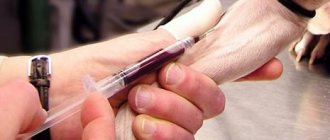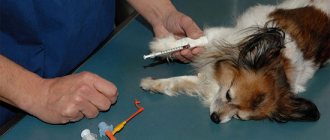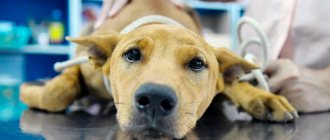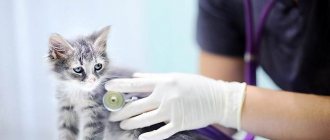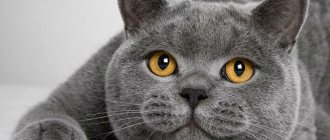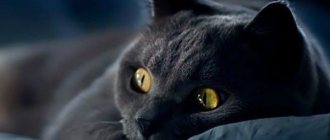Diagnosing diseases in pets is often difficult even for experienced veterinarians. Unfortunately, pets are not able to communicate the nature of their illness, and their behavior and symptoms are often differentiated, that is, they have signs of several ailments at once. To refute or confirm the diagnosis, as well as to identify hidden pathological processes in the animal’s body, the doctor needs not only to examine it, but also to obtain the results of laboratory tests. A blood test in cats is the most accurate laboratory method for studying the state of general health and specific organs. Today we will talk about general (clinical) and biochemical tests: how the procedure is carried out, what is the difference between the two types of studies, what indicators are considered normal.
Blood test in cats
Blood tests in cats: types and features of the procedure
Taking blood for analysis from representatives of the cat family is a mandatory test that can be useful in a number of situations. A blood test is taken from the animal to make a correct diagnosis, before surgical interventions, to determine the degree of general health of the cat, as well as for prevention.
Responsible owners, even if the animal is in excellent health, perform a blood test once a year in order to detect pathological processes in time, as well as determine whether the chosen diet is suitable for the animal
In cats, blood sampling for analysis is carried out in veterinary clinics, but if the test is carried out as a planned preventative measure, the veterinarian can go to your home so as not to put the cat into a stressful situation from traveling and staying in the clinic. Unfortunately, if your pet has already shown symptoms of any illness, calling a veterinarian at home is not advisable.
The procedure for collecting blood from a cat is similar to that of a human.
Despite the fact that a good veterinary clinic will definitely tell you about the results of a blood test, it will not be superfluous for owners to understand what they are talking about and know how the study is deciphered. We'll talk about this below. But first, let us note that in Russian veterinary clinics they do two main types of blood tests for cats - general and biochemical. These studies show different results, identifying different substances, so it is best to take them comprehensively.
Indications
Taking blood from cats and dogs is carried out for the same purpose as from people - to diagnose the condition of the body and identify various diseases. The analysis will also be required when performing blood transfusions between the donor and recipient.
Important! Transfusion (blood transfusion) is a complex and difficult manipulation that is performed strictly according to indications (oncological diseases, anemia, trauma, coagulation disorders, sepsis).
Analysis may be prescribed in the following situations:
- Diagnosis of the disease. The study will allow you to evaluate the level of leukocytes and other indicators, which may indicate the presence or absence of inflammation, various pathologies and other disorders of the body.
- Preoperative study. The test is almost always prescribed before surgery. It will minimize the risks that accompany any operation. It will also help to identify hidden problems in the functioning of the animal’s organs, which can negatively affect the cat’s condition after surgery.
- Preventive measures. The study can be initiated by the cat owner or the sanitary and epidemiological service in order to identify infectious agents in the animal if there is a high risk of developing dangerous diseases in this particular area.
We decipher the norms of a general blood test in cats
Clinical analysis of blood samples (usually called general analysis) demonstrates the condition of the cat’s body as a whole, recording how many elements - leukocytes and red blood cells - are in the animal’s hematopoietic system, and speaks about their quality. A general analysis also determines whether the animal is suffering from parasitic or infectious diseases. Let's consider what indicators are revealed during a clinical blood test, what they are responsible for and what diseases they may indicate, let's talk about what the indicators of a general blood test are normally in a healthy cat.
Table 1. Decoding biochemistry for cats
| Index | Norm | What is he talking about? |
| Platelets (PLT) | 300-630x10 9 /l | A reduced level of platelets may indicate infectious processes in the animal’s body, as well as pathologies in the bone marrow. An increase in platelets indicates internal bleeding, the presence of tumors, and an inflammatory process. Platelets also increase if the animal is being treated with corticosteroids or has recently undergone surgery. |
| Red blood cells (RGB) | 5.3-10x10 12 /l | A reduced number of red blood cells indicates anemia in the cat, hidden or obvious blood loss, and inflammation. Cats may experience decreased RGB levels before giving birth. An increased number of red blood cells is a factor indicating problems with the kidneys and liver, dehydration, oxygen starvation |
| Erythrocyte sedimentation rate (ESR) | 0-13 mm/hour | A reduced indicator, as is clear from the norm, does not exist. Too rapid sedimentation of erythrocytes indicates a cat’s state of shock, pre-infarction condition, poisoning, malignant tumors |
| Hemoglobin (HGB) | 80-150 g/l | Reduced hemoglobin is evidence of anemia, poisoning, damage to the cardiovascular and hematopoietic system, poisoning, bleeding. High hemoglobin indicates electrolyte imbalance or erythrocytosis |
| Hematocrit (HCT) | 24-27% | If the hematocrit does not reach the normal value, the cat may have tumors, chronic inflammation, or internal infusion. A high hematocrit indicates diabetes, low plasma levels in the blood, dehydration, elevated red blood cells (look at the indicators in combination) |
| White blood cells (WBC) | 5.5-18.0 x10 9 /l | White blood cells are below normal - the animal has suffered from radioactive radiation, suffers from bone marrow damage, or viral diseases. Leukocytes in increased numbers indicate oncology, bacterial infections, inflammation, leukemia |
| Eosinophils | 0-4% of normal leukocytes | There is no reduced number of eosinophils; an increase in their level indicates an allergic reaction or intolerance to any drugs or agents that are fed to the animal |
| Monocytes | 1-4% of normal leukocytes | A decrease in monocytes indicates taking medications from the steroid group, as well as anemia. Increase – about possible enteritis, fungal diseases, tuberculosis |
| Neutrophils | Band nuclear - 0-3% of the norm of leukocytes, segmented - 35-37% of the norm of leukocytes | Decreased quantity – anaphylactic shock, fungal diseases, bone marrow lesions. Increased norm – poisoning, tumors, leukemia, acute purulent or inflammatory processes |
| Lymphocytes | 22-25% of normal leukocytes | A decrease in the norm indicates ailments affecting the kidneys or liver, disorders of the immune system, and the presence of cancer. Increasing the norm - there is a virus in the body of a mustachioed pet, toxoplasmosis, leukemia |
A general blood test, as the name suggests, shows the overall health of the animal.
CBC in cats
A general blood test in cats gives a general idea of the physiological state of the body; the number of formed elements in the blood allows you to see the condition of the body as a whole. In addition, with a general blood test in a cat, it is possible to determine the presence of blood parasites, such as heartworms and hemobartenella.
To carry out this test, venous blood is taken from the cat and placed in a special tube with an anticoagulant, which prevents blood clotting and the destruction of blood cells.
There are standards that the results of a general blood test must meet, and deviations from this standard may indicate the presence of specific diseases.
So, the general norms for the results of a general blood test in a cat are as follows:
- Hematocrit - from 26 to 48%, an upward deviation indicates cardiac or pulmonary failure and erythremia;
- Hemoglobin - from 80 to 150 g/l, elevated hemoglobin levels may indicate dehydration of the body, some forms of hemoblastosis, for example, erythremia, a reduced level of hemoglobin in the blood of a cat indicates the presence of various types of anemia, possibly due to blood loss;
- Red blood cells - from 5.3 to 10 x 106 / ml, an increased level of red blood cells indicates erythremia, chronic lung diseases, heart failure, an increased diameter of red blood cells indicates dehydration of the body, lower levels also indicate anemia; An increase in the diameter of erythrocytes indicates a deficiency of vitamin B12 and folate deficiency anemia, liver disease; a small diameter indicates a deficiency of iron in the cat’s body and hemolytic anemia.
- Color index – from 0.65 to 0.9;
- ESR – from 0 to 13 mm/h, an increase in ESR means that inflammatory processes have begun in the cat’s body, poisoning or infection is possible, it is also a signal of tumors, invasions, an increase is considered normal after surgery or after injuries;
- Leukocytes – from 5.5 to 18.5x103 /ml. With elevated levels of leukocytes, most likely, inflammatory processes are occurring in the cat’s body, viral infections are developing, and allergic reactions are present. Or is it a consequence of poisoning. Also, elevated rates indicate tumors, invasions, lymphocytic leukemia and myeloid leukemia, leukocyte counts are reduced in liver diseases, after exposure to antibiotics, toxic substances, and the cat may also have some kind of autoimmune disease, radiation sickness, agranulocytosis or aplastic anemia;
- Segmented neutrophils - from 35 to 75%, increased readings of neutrophils indicate inflammatory processes, shock, poisoning, hemolytic anemia;
- Band neutrophils - from 0 to 3%, an increase in band neutrophils means the presence of malignant tumors, sepsis or myelocytic disease, a decrease in indicators can be provoked by viral infections, toxic substances, cytostatics, radiation sickness;
- Lymphocytes – from 20 to 55%, increased levels of lymphocytes mean the development of infection;
- Monocytes - from 1 to 4%, a level of 5% indicates chronic infections, chronic monocytic leukemia and tumors;
- Eosinophils - from 0 to 4%, increased deviation from the norm is possible with allergic reactions, hematological malignancies, sensitization, tumors and invasion;
- Platelets - from 300 to 630x103 / l, a deviation from the norm to a greater extent indicates myeloproliferative diseases, lower levels indicate acute chronic leukemia, aplastic anemia, autoimmune hemolytic anemia, liver cirrhosis, lupus, rheumatoid arthritis, with small deviations chronic infections are possible intoxication or allergy
- Basophils are rare, their appearance means the development of hemoblastosis;
- The detection of myelocytes indicates chronic myeloid leukemia, acute or chronic inflammatory processes, possibly bleeding and sepsis.
Deciphering the norms of cat blood biochemistry
Biochemistry or biochemical blood test is a detailed and accurate laboratory test based on the indicators of various elements that play a key role in the life of a mustachioed pet. The picture of enzyme activity allows us to draw conclusions about the degree of health or damage to various internal organs of the animal, respectively, to understand the deep processes taking place in all systems, departments and organs.
The picture of enzyme activity allows us to draw conclusions about the degree of health
Let us consider separately groups of substances and elements, the relationship to the norms of which is shown by biochemistry:
- Total protein and albumin reflect how correctly the metabolism of amino acids occurs in the body, which plays a vital role in the cat’s life. During this exchange, beneficial substances are transferred and stored, blood pressure is regulated, and reserve forces are accumulated to fight diseases and support the immune system.
- Glucose is an indicator that reveals the norms of functioning of the enzyme system, as well as specific organs (liver, pancreas, kidneys).
- Bilirubin is a component whose quantity can be used to track changes in the functioning of the liver and biliary system.
- Cholesterol is a structural component on which the quality of lipid metabolism in a cat depends.
- GGT is a liver type of enzyme that regulates the functions of the gallbladder and ducts, thyroid gland, and pancreas.
- Amylase, a component considered in conjunction with other elements, shows how the pancreas and parotid (saliva production) glands function.
- ALT and AST are enzyme substances produced in the liver and skeletal tissues, heart muscle, indicating the functioning of these systems and departments.
- Alkaline phosphotase is a component on which the correct functioning of the liver depends.
- Creatinine and urea are products of muscle breakdown that are excreted from the cat’s body by the kidneys. The level of these components indicates healthy or, on the contrary, improper functioning of the excretory system.
- Calcium is an element that conducts nerve current impulses. Its normal level indicates problems with the circulatory and cardiovascular systems.
- Triglycerides characterize the energy metabolism of an animal, the functioning of the heart and blood vessels.
- Electrolytes demonstrate the conductivity of nerve fibers and the execution of brain commands.
The advantage of biochemical (detailed) analysis is the ability to clearly see problems in entire organ systems, individual organs and their departments, to assess the degree of disorders and their causes with high accuracy. For clarity, we will present the decoding of biochemistry according to the animal’s organs or important life processes.
Increases and decreases in the norm of indicators in biochemistry often indicate the same pathological processes
Table 2. Water and electrolyte balance
| Index | Norms | What does it indicate? |
| Potassium | 3.8-5.4 mmol/l | Above this level indicates problems with the thyroid gland, hypovitaminosis (lack of vitamin D), formations (cysts, tumors) of various origins, and kidney failure. A decrease in the norm indicates hyperfunction of the adrenal glands, chronic starvation of the animal, and dyspeptic disorders. |
| Chlorides | 106-124 mmol/l | An elevated level indicates traumatic brain injury, impaired functioning of the kidneys and adrenal glands, and an overdose of steroid drugs. |
| Iron | 20-31 mmol/l | If the element exceeds normal levels - liver disease, inflammatory processes in the kidneys, metal intoxication. Decrease in quantity - malignant or benign formations, infection, anemia, post-operative syndrome |
| Phosphorus | 1.2-2.4 mmol/l | In excess of the normal amount - kidney disorders, genitourinary system disorders, diabetes. Below the limits of the indicated indicators - rickets, disorders of the gastrointestinal tract |
| Sodium | 142-166 mmol/l | Above the normal level - diabetes mellitus and frequent urination due to it, problems with water metabolism, kidneys, excessive amounts of salts. Reduced sodium norm - heart failure, edema in the animal, kidney pathologies, taking diuretics, diabetes mellitus. Decrease in quantity - nephritis, dyspeptic disorders, accumulation of carbon dioxide in the blood |
Biochemical analysis allows the veterinarian to assess the condition of the cat’s internal organs
Table 3. Protein level (hormonal levels)
| Index | Norm | What does it indicate? |
| Albumen | 23-37 g/l | A decrease or increase in the amount is confirmed by the protein (total) results. A fall or increase in the amount of albumin occurs only against the background of a similar fall or increase in protein in general. The difference in the obtained digital values may indicate an analysis error |
| Complete protein | 55-78 g/l | An increase in the norm indicates chronic inflammatory processes, possible burns, autoimmune diseases, and electrolyte imbalance. Decrease in quantity - serious disturbances in liver function (hepatitis, cirrhosis), blood loss, parasitic infestations, animal starvation, intestinal and kidney pathologies |
Table 4. Pancreas, liver, kidneys
| Index | Norm | What is he talking about? |
| Amylase | 779-1725 units/l | Increased rate: peritonitis, intestinal or gastric volvulus, severe intoxication, pancreatic inflammation, kidney failure, diabetes mellitus, inflammatory process. Decreased norm: poisoning, pancreatic necrosis. |
| AST | 9-28 units/l | An increased rate indicates excessive physical activity of the animal, sun or heat stroke, heart failure, liver disease, and oncological processes. A reduced norm against the background of an increase in ALT is infectious hepatitis. |
| ALT | 19-78 units/l | Increased norm: large area burns, liver intoxication, muscle microtrauma or destruction of muscle tissue, cirrhosis, jaundice. Reducing the norm does not matter. |
| Alkaline phosphatase | 38-56 units/l | Increase: fractures, tumors in the bone region, bacterial diseases and damage to the intestines and stomach, liver, diet oversaturated with fats, pregnancy, formations in the gallbladder ducts or the organ itself, damage to bone tissue. Decreased: anemia, vitamin C deficiency. |
| L-genase | 55-155 units/l | Increased: necrosis, tumors, pancreatitis, leukemia, infectious peritonitis, heart attack suffered on the legs, skeletal injuries, anemia, nephritis. |
| Urea | 2-8 mmol/l | Increased indicators: food rich in protein above normal, kidney disease, post- or pre-infarction, shock, anemia, stress, overstrain of the cat’s nervous system. Decreased: chronic pathologies in the liver, diet poor in proteins. |
| Cretinin | 70-165 mmol/l | An increased rate indicates dehydration of the body, blockage of the duct that removes urine, and kidney dysfunction. Reduced rate: decreased muscle tone and volume, pregnancy. |
| Total bilirubin | 3-12 mmol/l | Increased norm: excess vitamin B12. Decreased normal: amenia, tissue fibrosis, diseases or formations in the bone marrow. |
| GGT | 5-50 units/l | Above normal: hepatitis, pancreatic malfunction, poor flow of bile or its stagnation, cirrhosis. |
Biochemistry shows hidden pathologies in the body, including chronic ones
Table 5. Other indicators, other elements
| Index | Norm | What is he talking about? |
| Magnesium | 0.72-1.2 mmol/l | Elevated levels - injuries, dehydration, insufficient kidney function. Decreased - direct magnesium deficiency, pancreatic dysfunction and inflammation, dyspeptic disorders |
| Calcium | 2-2.7 mmol/l | Excess vitamin D, cancer, leukemia, chronic kidney failure, and bone diseases are observed above normal levels. Less than normal - pancreatitis, rickets (little vitamin D in food), liver disease, pancreas (pancreatitis), excessive pathological softness of bones, tissue destruction |
| Cholesterol | 1.2-3.8 mmol/l | An increase in these values means kidney disease, diabetes, pancreatic dysfunction. Decreased - intestinal problems, poor diet, malignant formations |
| Glucose | 3.1-6.5 mmol/l | If elevated, there are pathologies of the thyroid or pancreas, diabetes, and stress. If it decreases, liver damage, prolonged fasting, endocrine system failure, insulin overdose |
| Triglycerides | 0.38-1.1 mmol/l | In excess of the specified amount - liver damage (cirrhosis, jaundice), chronic stress in the animal, hepatitis, pre-infarction condition, ischemia, renal dysfunction, diabetes. Indicators below the lower limit - infectious lesions, lung dysfunction, prolonged fasting or poor diet |
Based on the information provided in the tables, as well as their effect on the cat’s body, it is easy to understand: both studies are of paramount importance when monitoring the animal’s condition, making a diagnosis, adjusting nutrition and lifestyle.
Biochemistry and general analysis complement each other, showing a complete picture of the animal’s health
Biochemical analysis of cat urine - conflicting results
Anonymous user
604 views
April 22, 2020
Hello! I have a sterilized Siberian cat, age 6 years and 4 months, weight 5.5 kg. The cat lives only in the apartment and never goes outside. I feed my cat high-quality dry grain-free food for sterilized cats “Gosbi Original Cat Grain Free Sterilized” (Spain) and canned food for sterilized cats from this manufacturer. This food has a low protein content of 32% (which is less, for example, than ProPlan food for sterilized cats, which has 41% protein). Gosbi food is free of grains, corn and wheat gluten and consists of natural ingredients, including algae, fruits and vegetables rich in natural antioxidants. In accordance with the feeding standards specified by the food manufacturer, as well as age and weight, the cat is given a minimum amount of food, which the cat, as a rule, does not eat completely, which indicates that the cat is not overfed. Also, once a day, along with food, according to the recommended norm, the cat is given Beaphar Malt Paste for hair removal (manufactured in the Netherlands). Regarding the cat’s drinking water, I can explain that (surprisingly), compared to the cats of my friends and relatives, my cat, so to speak, even drinks water with pleasure. In addition to the fact that her water is always fresh, containers with water are placed in the rooms of the apartment, the cat periodically drinks water on her own, so I also supplement the cat with water, bringing her a container of water in the evening (before bed), in the morning and during the day. Therefore, it seems to me that the cat consumes a sufficient amount of water. In my opinion, the cat's urination is normal. In a small way, she walks 2 - 3, and sometimes 4 times during the period from 6.00 to 24.00 hours. In general, a cat usually walks 2 times during the specified period. The cat's behavior is normal - no different from usual, stool and urination are normal. There is constant access to fresh water. I constantly monitor the cat’s health – we periodically take urine tests (general and biochemical); stool analysis, including parasitological examination; blood tests (general and biochemical); SDMA analysis, ultrasound. Regarding the findings of the ultrasound, I can explain that the last time an ultrasound of the abdominal cavity was performed was in the fall of 2021 (unfortunately, I cannot indicate the date, since the results were not found), but before this ultrasound was performed on March 20, 2019, and the results, as I remember, were the same, namely: “moderate hepatosis, impaired renal function, chronic cystitis.” The same results were indicated earlier, even when all the tests in the cat were normal. I can’t say anything bad about the doctor who performed the ultrasound (and this is not the place to evaluate the doctors’ performance or criticize), but it seems that the text of the ultrasound study is always practically the same, and is written as if according to a template. At least, the above conclusion was present both when the cat did not have any deviations from the norm in the tests, and when there were any. Previously (2 years ago), when the cat was fed ProPlan food for sterilized cats (dry and canned), unorganized sediment (single tripel phosphates) systematically began to appear in the cat’s urine and also, at the same time, the level of protein in the urine sometimes increased. Because of this, temporarily (from 2 weeks to 1 month) it was necessary to feed the cat Purina UR medicinal food (dry and canned), as a result of which tripelphosphates disappeared, and the level of protein in the urine returned to normal. The use of Gosbi has eliminated intermittent problems with loose sediment (single tripel phosphates), but urine protein levels are still sometimes higher than normal. QUESTION: Based on the test results below, I ask you to inform me about the supposed reasons for the excess of such important indicators as urine urea, urine creatinine, urine protein and others from the norm against the background of the fact that such important indicators as SDMA, protein ratio are normal /creatinine and urine urea/creatinine ratio (in urine biochemistry), as well as all indicators of a biochemical blood test. I also ask you to inform me about the possible reasons for the excess and decrease (compared to the normative ones) of some indicators of the clinical (general) blood test given below. Are deviations from the norms of some indicators of fundamental importance if they are insignificant? Is it acceptable to use “Purina UR” to lower the level of protein in a cat’s urine, given that previously the use of this medicinal food for from 2 weeks to 1 month normalized the level of protein in the urine along with the removal of unorganized sediment (single tripel phosphates ) and also taking into account the fact that at the moment there is no unorganized sediment and single tripel phosphates? During the next test on March 11, 2020, almost all the indicators of the above tests are normal, with the exception of the following: Clinical (general) urine test: Urine protein (semi-quantitative determination) = 300 mg/dl (with a norm of no more than 30). ? Relative density according to the refractometer (RD) = 1.056 g/cm3 (normal!) pH = 6.5 pH units (normal!) Other indicators are also normal. Biochemical urine analysis: Urea urine = 1512.3 mmol/l (with the norm not exceeding 312)? Excess by 4.8 times. Urine creatinine = 44.8 mmol/l (with the norm not exceeding 25)? Excess by 1.8 times. Urine protein (quantities) = 47 mg/dl (with the norm not exceeding 30)? Excess by 1.6 times. Protein/creatinine ratio = 0.09 (normal!) Urine urea/creatinine ratio = 33.73 mmol/l (normal!) SDMA study = 12 mg/dL (normal!) (average for species 0 -14) Biochemical blood test (all indicators are normal!): Total bilirubin (TBil) = 4.5 µmol/l (normal < 10 µmol/l). Direct bilirubin (DBil) = 3.2 µmol/l (normal < 5.5 µmol/l). ACT (GOT) = 22 U/l (normal 12-45 U/l). ALT (GPT) = 29 U/l (normal 18-60 U/l). Ritis coefficient = 0.7 (norm 1.1 – 1.3). Urea (Urea) = 5.9 mmol/l (normal 5.4 – 12.1 mmol/l). Creatinine (Creat) = 123 µmol/l (normal 70 – 165 µmol/l). Total protein (Prot, total) = 76 g/l (normal 57 – 78 g/l). Albumin (Alb) = 41 g/l (normal 24 – 38 g/l). Excess by 3 g/l. Alkaline phosphatase (ALP, IFCC) = 49 U/l (normal < 55 U/l). Alpha-Amylase, total (α-Amylase, total) = 901 U/l (normal 500 - 1200 U/l). Glucose (Glu) = 4.7 mmol/l (normal 3.3 – 6.8 mmol/l). LDH (LDH, IFCC) = 68 U/l (normal 35 - 500 U/l). Phosphorus (Phosphate, inorg) = 1.48 mmol/l (normal 1.10 – 2.30 mmol/l). Albumin/globulin (A/G Ratio) = 1.18 calculated g/l (normal 0.70 – 1.40 calculated g/l). Globulin (Glob) = 35 g/l (normal 29 – 55 g/l). Urea/Creatinine ratio (B/C Ratio) = 25.4 mg/dl (with azothermia: > 30 pre-/postrenal; < 20 renal A. or other reason) Clinical (general) blood test: All indicators are normal, for with the exception: Hematocrit (Hct, PCV) = 55.1% (with an average norm for the species of 29 - 48%), an excess of 7.1%. Hemoglobin (Hgb) = 183 g/l (with an average norm for the species of 90 – 150 g/l), an excess of 33 g/l. Red blood cells (RBC) = 11.6 x10¹²/l (with an average norm for the species of 5.6 - 10.0 x10¹²/l), an excess of 1.6. Leukocytes (WBC) = 2.9 x10 9 /l (with an average norm for the species of 5.5 - 18.5 x10 9 /l), below the norm by 2.6 x10 9 /l)?. Eosinophils (Eos) = 9% (with an average norm for the species of 0 - 6%), an excess of 3%. ? Corrected (true) leukocytes = 2.9 x10 9 /l (with an average norm for the species of 5.5 - 18.5 x10 9 /l), below the norm by 2.6 x10 9 /l)?. Segmented neutrophils ABS = 1.65 x10 9 /l (with an average norm for the species of 2.50 - 12.50 x10 9 /l), below the norm by 0.85 x10 9 /l)?. Lymphocytes ABS = 0.93 x10 9 /l (with an average norm for the species of 1.50 - 7.00 x10 9 /l), below the norm by 0.57 x10 9 /l)?. When the tests were repeated a month later, on April 18, 2020, approximately the same results were obtained as previously, on March 11, 2020. At the same time, some indicators that deviate from the norm have changed slightly, namely: Clinical (general) urine analysis: Urine protein (semi-quantitative determination) = 100 mg/dl (with a norm of no more than 30). ?. In March 2021, this figure was 300 mg/dL. Relative density according to the refractometer (RD) = 1.072 g/cm3 (at a norm of 1.036 – 1.060 g/cm3), an excess of 0.012 g/cm3. pH = 6.0 pH units (normal and decreased compared to March 2020) Other indicators are also normal. Biochemical urine analysis: Urea urine = 1609.9 mmol/l (with the norm not exceeding 312) ? Excess by 5.2 times. Urine creatinine = 44.2 mmol/l (with the norm not exceeding 25)? Excess by 1.8 times. Urine protein (quantities) = 57.2 mg/dl (with the norm not exceeding 30) ? Excess by 1.9 times Protein/creatinine ratio = 0.11 (normal!) Urea/creatinine urine ratio = 36.43 mmol/l (normal!) I really hope to receive a competent, professional answer. Thank you.
The question is closed
No reward
How is a cat's blood sample taken for testing?
Many owners are afraid to donate blood with their pets, worrying that the cat will be in too much pain. In fact, the procedure takes less than five minutes and the animal experiences no pain. In any veterinary clinic where such tests are performed, doctors have to carry out the procedure every day, so all actions are honed to the point of automation.
When blood is taken, the cat feels almost no discomfort
So, for general analysis and for biochemical analysis, blood is taken from the vein of the animal. To do this, the cat is placed on its side or secured in a special veterinary bag (if the pet actively resists). Typically, the analysis is taken from the front paw, it does not matter whether it is right or left: for this, a small area of fur is shaved off with an electric razor. Then a syringe needle or intravenous peripheral catheter is inserted into the vein, from where the biological material flows into the test tube. For clinical analysis, about two milliliters of blood is required, for biochemistry - half as much, given that the blood will be placed in a special machine to obtain serum.
An anesthetic is sometimes used when drawing blood.
Sometimes local anesthetic sprays are applied to the animals to prevent the cat from squirming when the skin is pierced with a needle. Since the pet needs to be held for some time in order to receive the required amount of material, this measure is justified. Without feeling any pain, the cat will quietly await the end of the procedure. But, as practice shows, most cats donate blood well even without pain relief. After the procedure, a tight bandage is applied to the animal’s paw, which the owner removes independently after an hour and a half.
Preparing a dog, cat, bird for donating blood for tests
Proper preparation for a blood test will help you obtain accurate and reliable results. Sometimes research results differ from the actual picture only because the pet was not properly prepared. If the results appear unreliable, a repeat blood test may be required.
Is the preparation of the animal the same for all blood tests? No. Blood tests for dogs and cats can be divided into two groups. Preparation for these two types of tests is slightly different.
A routine blood test provides a general assessment of an animal's health and is performed on healthy dogs, cats, birds and rodents as well as sick ones. A routine visit to your veterinarian may include routine blood work. By properly preparing your pet for blood testing, you can save time and money by reducing the need for additional tests and repeat visits to the veterinary clinic.
Summarizing
The times when cats were treated “by touch” and “by eye” are long gone. Modern technologies make it possible to conduct many studies for animals, including accurate and quick blood tests, on the basis of which the most accurate diagnosis can be made and a treatment plan can be outlined. There is no need to refuse tests if your veterinarian has prescribed such a study. The animal will not suffer as a result of the manipulation and will not experience severe pain, but deciphering the analysis will allow you to avoid guessing about what specific ailment has affected the pet.
